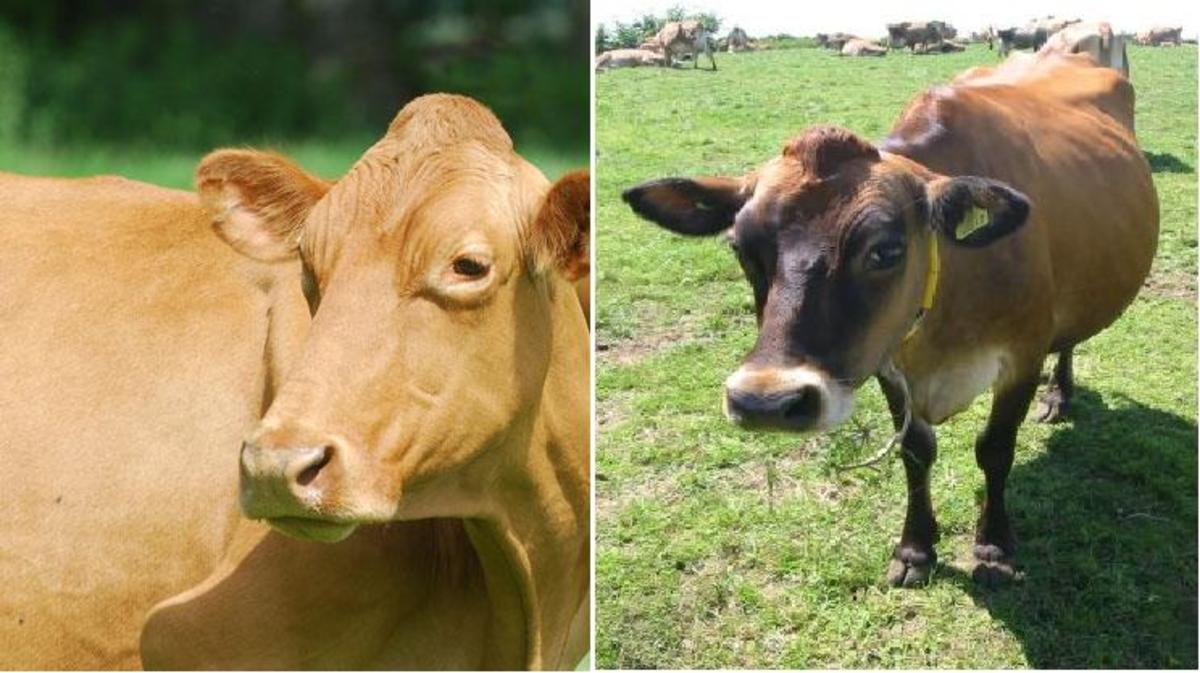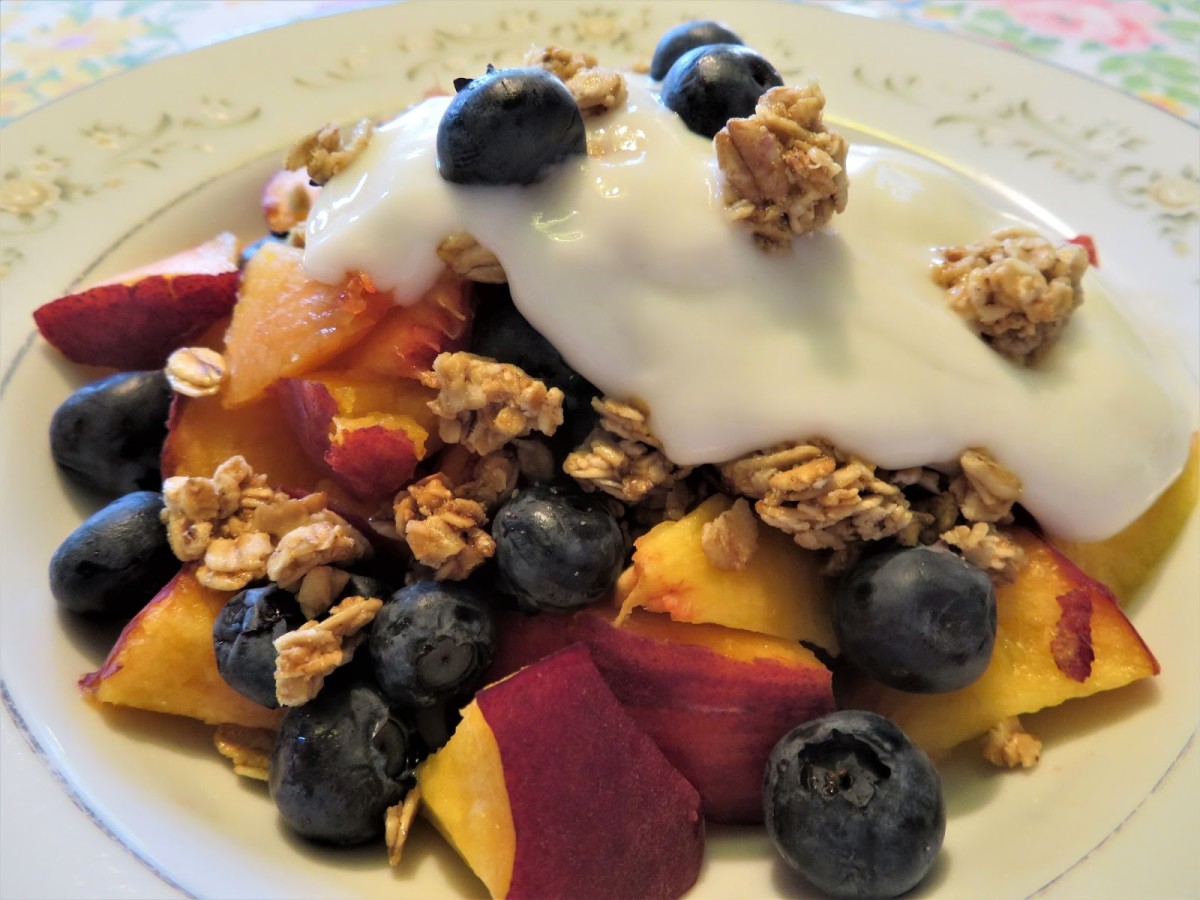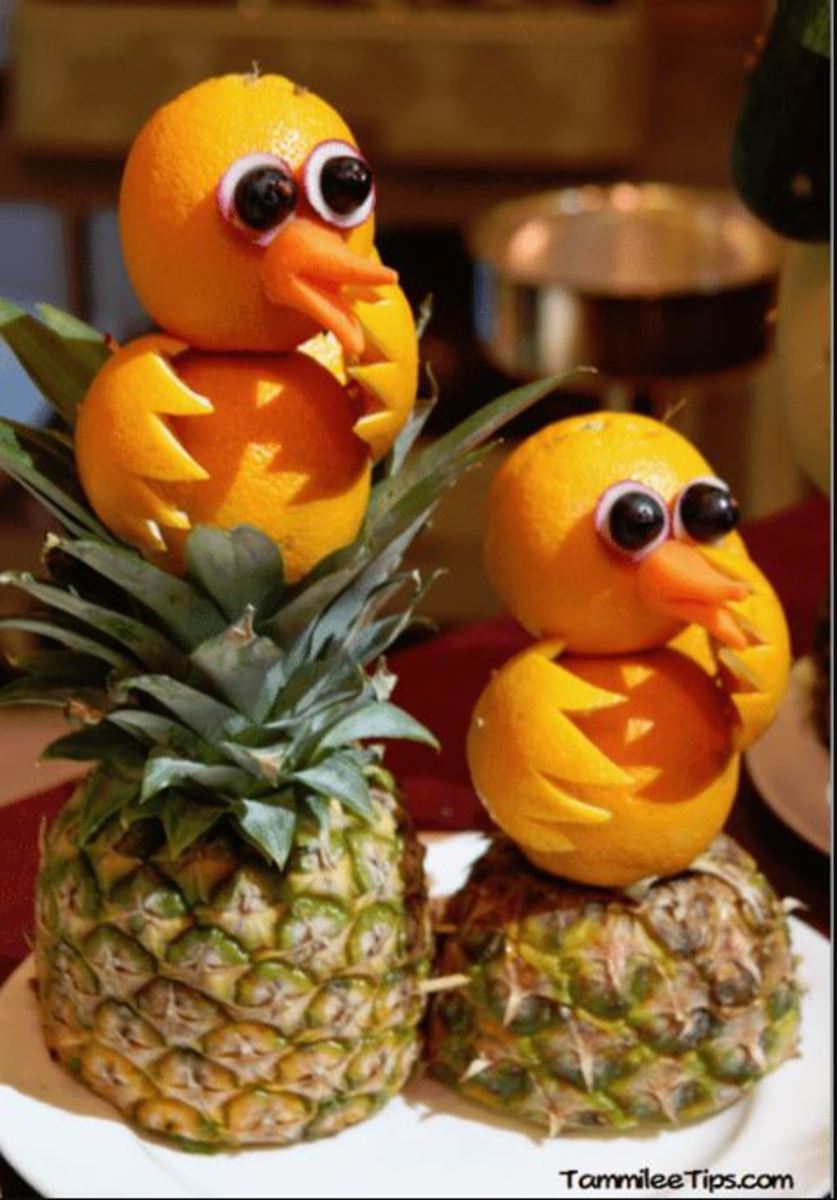Easy Nutrition Guide for Toddlers
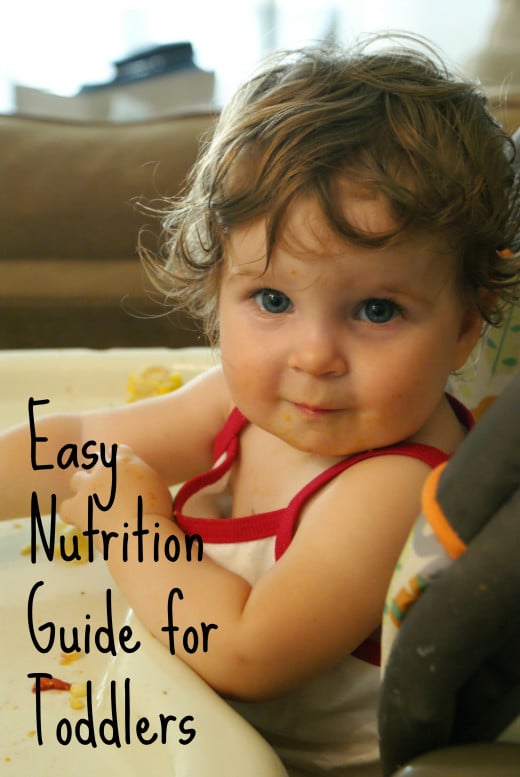
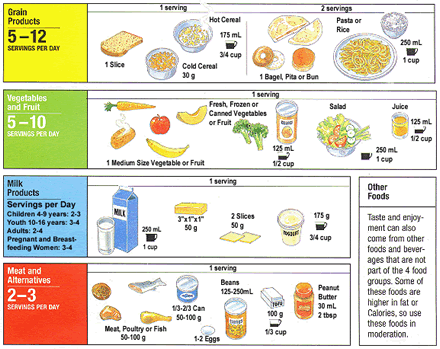
Chances are you've seen a food pyramid like the one to the right in your high school health class or at the doctors office. A diagram like this can make it easier to make smart food choices, but when you are cooking for a toddler, it can be difficult to know how many servings per day your little guy should be getting.
Most articles (such as this chart from Canada's Food Guide or this poster from My Plate) will tell you to give your child the lowest number of adult servings (in the case of 2-3 year olds, 4 fruit and veggie servings, 3 grain products, 2 dairy, 1 meat) and while this is sound advice, it can often be difficult to divide these portions up throughout the day.
As an alternative, use the typical range of servings suggestions listed on any food pyramid or My Plate, keeping in mind these smaller serving sizes:
Serving Sizes
Food Group
| Toddlers
| Preschoolers
| Older Children
|
|---|---|---|---|
Breads & Starches
| |||
Bread
| 1/4 slice
| 1/2 slice
| 1 slice
|
Rice / Pasta / Cooked or Dry Cereal
| 1/4 cup
| 1/3 cup
| 1/2 cup
|
Fruits
| |||
Fresh Fruit
| 2 Tbsp
| 1/4 cup
| 1 piece
|
Juice
| 1/4 cup
| 1/2 cup
| 3/4 cup
|
Canned Fruit
| 1/4 cup
| 1/2 cup
| 1/2 cup
|
Vegetables
| |||
Cooked or Raw
| 2 Tbsp
| 1/4 cup
| 1/2 - 1 cup
|
Milk & Dairy
| |||
Milk or Yogurt
| 1/2 cup
| 3/4 cup
| 1 cup
|
Cheese
| 1 oz
| 1 1/2 oz
| 2 oz
|
Meat & Protein
| |||
Lean Meat
| 1 oz
| 1 1/2 oz
| 2-3oz
|
Cooked Beans
| 2 Tbsp
| 1/4 cup
| 1/2 cup*
|
Egg
| 1/2
| 1
| 1*
|
Peanut Butter
| 1 Tbsp
| 2 Tbsp
| 2 Tbsp*
|
* Count as only 1oz meat or 1/3 of serving
|
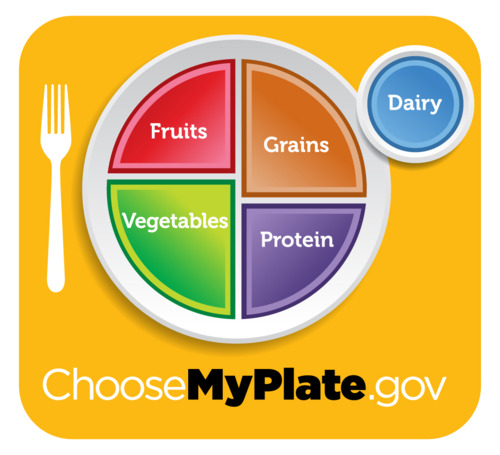
Now that you know the basic serving amounts for each age group, you can personalize the number of servings based on the activity level and size of your child.
It is also important to note the importance of healthy fats in the development of children's brains and bodies. NEVER give your children non-fat dairy products unless specifically advised by your Doctor. Milk in its original form is produced as a whole package (fats, proteins and sugars) and is meant to be consumed that way to provide the proper benefits to your body. You can get the proper nutrition without drinking cow's milk (with the proper substitutions) but consuming the milk without the fat removes all nutritional value.
Here is how you could breakdown the above recommended servings over your child's day (for a 1-3 year old):
Breakfast (1 dairy, 1 fruit, 2 bread/starches)
1/2 cup milk
1/4 cup fruit
1/4 cup cereal
1/4-1/2 slice bread
Snacks (1 bread/starch, 1 protein OR vegetable, EACH SNACK)
1/4-1/2 slice bread (or 1 graham cracker square)
2 Tbsp nut butter (for 1st snack)
2 Tbsp raw vegetables (for 2nd snack
Lunch & Dinner (1 dairy, 1 protein, 1 fruit, 1 vegetable, 1 bread/starch EACH MEAL)
1/2 cup milk
1 serving meat/meat alternative
2 Tbsp vegetables
2 Tbsp fruit
1/4 to 1/2 slice bread
Total: 3 dairy, 3 fruit, 3 vegetables, 6 bread/starches, 3 protein
If your child is very active, increasing the number of starches and fruits will help provide them with the energy they need throughout the day. You can also try increasing the serving size of proteins at mealtime. It is also beneficial to remember that kids (especially toddlers) will not eat a consistent amount at every meal and snack. Try to consider how their nutrition averages out over the whole day (or even week) rather than each meal (this also can help prevent negative food patterns with your pressuring and them resisting!).
Smart Meal Planning
Pick and choose from the ideas in each good group to help increase the variety and nutrition in your child's daily intake. All are toddler favorites in a format they can feed to themselves.
Breads & Starches (TIP: Many hot breakfast items can be made in bulk and frozen ahead of time and simply reheated in the microwave or toaster oven when needed).
Whole wheat pancakes or waffles, cut into squares
Oatmeal
Pretzels
Bagels or toast
Mini muffins
Crackers
Fruits & Vegetables (TIP: Cut up your fruits and vegetables at the beginning of the week to have quick meal makers. Steaming harder veggies ahead of time can save time too!)
Broccoli
Carrots
Cauliflower
Cucumber
Green Beans
Sweet Peppers
Tomatoes
Turnip or parsnip slices
Summer squash slices
Apple, peach or pear slices
Banana
Citrus segments
Balled melon
Grapes
Raisins
Dried fruit
Berries
Dairy (TIP: freezing milk or yogurt into popsicle molds can make for fun snacking.)
Milk
Cheese sticks/slices
Cottage cheese
Yogurt (fruit sweetened only!)
Protein (TIP: Cook some meat and eggs up ahead of time for easy and quick portions!)
Cold turkey, chicken, ham or roast beef (preferably homemade, but deli is OK too)
Hard boiled eggs
Scrambled eggs
Peanut/Nut butter
Beans
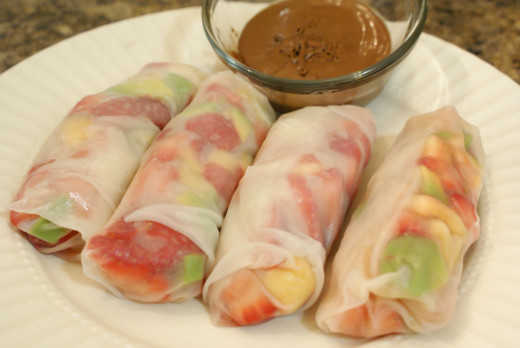
Time Saving Recipes
The best toddler foods are the ones they can feed themselves quickly and with little mess - any recipe that combines a few food groups into each bite help ensure the best nutrition. Here are a few things you can make (with make-ahead instructions!) that are quick and well-loved!
French Toast (Protein, grains, fruits & dairy)
- 2 eggs
- 3/4 cup milk
- 1 teaspoon ground cinnamon (adjust for your child!)
- 2 Tablespoons brown sugar, honey or maple syrup)
- 1/4 cup unsweetened applesauce
- 6 slices of whole grain bread
Mix first 5 ingredients together in a shallow dish. Soak each slice of bread in the mixture than cook on a buttered skillet. Makes 6 slices (~12 toddler servings).
Make-ahead: Cook as directed then allow to cool. Slice into fingers if reheating in microwave or toaster oven (keep whole for in toaster). Flash freeze on a baking sheet then toss it all in a freezer bag.
Smoothies (Fruits, dairy, protein)
1/2 cup plain yogurt
1 Banana, fresh or frozen
1/2 cup Strawberries, fresh or frozen
4 Tbsp. Peanut Butter
1/2 cup milk
1 cup ice (less w/ frozen banana!)
Optional
1 Tbsp ground flax seed or wheat bran/germ)
1-2 raw eggs (fresh from organic farm you trust - you can't know the freshness of store bought eggs)
Add to blender in order shown. Blend well and serve. Makes 3 cups (~6 toddler servings).
Made-ahead: Freeze in small mason jars or freezable plastic containers leaving head space. Put in fridge night before serving. Shake and serve!
Breakfast Roll Ups (Grains, dairy/protein, fruit)
Whole Wheat Tortilla wraps
Cream Cheese (plain OR fruit) OR Peanut/nut butter
Fruit (berries, shredded apples, banana slices, raisins, diced fruit, etc.)
Spread cream cheese on one side of wrap. Layer fillings on, pressing them into cream cheese and leaving ~2" on one side (to prevent oozing fillings). Roll wrap and slice if desired (kids do like the look of the pinwheels!).
Lunch Roll Ups (Grains, dairy/protein, vegetables)
Whole wheat or vegetable tortilla wraps
Cream cheese (plain or herb and garlic)
Cooked meat
Veggies (spinach, tomato, cucumber, shredded carrot, diced broccoli or sweet peppers, etc.)
See instructions above!
As you can see, these are a really flexible option! Use whatever meat, cream cheese, and veggies you've got on hand (and that your toddler loves!) to make an easy meal or snack.
Ham Cups (Protein, veggies, dairy)
6 slices ham
Diced veggies (mushrooms, sweet peppers, tomatoes, corn, etc.)
6 eggs
Cream
Parmesan (optional)
Press ham slices into muffin cups. Add diced veggies to the bottom of each ham cup, then crack an egg in each. Top each with a bit of cream and a sprinkle of Parmesan or other cheese. Bake at 425F for about 15-20 minutes (til eggs no longer jiggle). Makes 6 ham cups (~12 toddler servings).
Make-ahead: Cool, flash freeze and bag. When ready to serve, microwave until hot.
Other recipe ideas:
Fiber Muffins (All Things Thompson blog)
Meal Ideas (Snyders Tell All blog)
Cucumber & Cheese Rolls (Good Life Eats blog)
Sandwich Sticks! (Super Healthy Kids)
Homemade Cheez-its (Good Cheap Eats) Serve with sliced apples!


